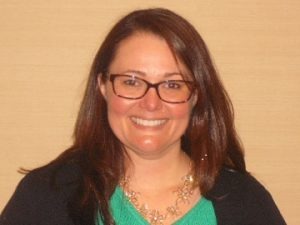Catch a Falling Star
The Isabella Geriatric Center has mounted a multifaceted attack on resident falls
BY YAFFA UNGAR, PT
The staff at Isabella Geriatric Center has always been strongly committed to the reduction of falls among our residents. We strive to provide a safe environment while continuing with our successful efforts to remain “restraint-free.” A specialized Fall Prevention Committee was formally established in 1997, whose mission is the reduction of falls through a systematic, multidisciplinary team approach. Members of the committee include representatives from nursing, administration, medicine, rehabilitation, security, maintenance, environmental services and pharmacy. A very successful “falling star” identification program was initiated in 1997 to identify those residents at high risk for falls. A colorful “falling star” sticker is placed over the bed and on the side of the wheelchair and/or assistive device of any resident identified by the interdisciplinary team as high risk. This program serves as an alert to all staff, including clinical (medical, nursing, rehabilitation, dietary and social service) as well as housekeeping, laundry, maintenance and clerical staff.
The colorful star is a signal to observe the resident closely and to intervene if the resident displays any unsafe behaviors (e.g., getting up from his/her wheelchair without the necessary assist). All staff are regularly in-serviced on this program on a departmental level and during the semi-annual facility-wide mandatory education programs.
The environmental services and maintenance departments continue with their weekly rounds to ensure environmental safety. These rounds ensure that there is proper lighting throughout the facility, that the beds are in good working condition (including the brakes), that there are no water-spillage problems, and that all the flooring, baseboards and handrails are secure and intact. Early on, the floor wax was changed to a slip-resistant product.
Most recently, the members of the Fall Prevention Committee custom-designed a fall risk assessment tool with associated protocols tailored to our geriatric population (Figure). This tool lists 12 major fall risk factors, with a point value assigned to each factor. If the total score is between 3 and 7 points, Fall Prevention Protocol I is initiated (Table 1). If the score ranges between 8 and 16, the more aggressive Fall Prevention Protocol II begins (Table 2). If five falls occur within 60 days, a special team meeting is scheduled. This fall risk assessment tool is applied by the nurse to all admissions and readmissions and upon a resident’s fall. Our interdisciplinary team has reported that the tool heightens its awareness to the level of fall risk. The carefully designed protocols delineate many interventions available for fall prevention. Protocol I includes such choices as reinforcing use of the call bell, adjusting the bed to its lowest position, rehabilitation screens, medication reviews, and education of resident and family.
Protocol II interventions include initiation of falling star identification, use of chair and/or bed alarms, use of low beds, wheelchair seating alternatives, use of protective equipment (helmet, hip pads), half-hourly resident checks and room changes. Any intervention is implemented immediately and documented in the resident care plan. Isabella’s management information services (MIS) department helped with the design of a specialized database for the collection of all accident/incident data, including falls. This database assists staff in identifying any trends regarding falls.
Parameters that are tracked include:
- time of fall/shift
- location of fall/unit
- location and type of any resulting injury
- treatments administered and referrals made
Table 1. Fall Prevention Protocol I.
- Fequently reorient and repetitively reinforce use of call bell and ensure it is within reach.
- Reassess for a clutter-free, well-lit environment.
- Consider adjusting bed to its loweest position.
- Reinforce use of assistive devices, if used.
- Reassess for safe footwear.
- Monitor use of eyeglasses and hearing aid, if applicable.
- Consider rehabilitation screen, if appropriate.
- Institute bowel/bladder routine program, as appropriate.
- Conduct a medication review.
- Evaluate the need for an adjustment in resident’s daily activity schedule.
- Educate resident’s family/significant other regarding these interventions and encourage family assistance and support.
Table 2. Fall Prevention Protocol II.
- Initiate falling star identification.
- Implement chair or bed alarm, as appropriate.
- Implement low bed, as apropriate.
- Implement wheelchair seating alternatives (wedge cushion, reclining chaire; contact OT Dept.), as needed.
- Implement use of protective equipment (helmets, hip pads), as indicated.
- Initiate half-hour/hourly checks and/or placement of resident at nursing station, as needed.
- Consider room change.
Isabella continues to purchase and use wheelchair and bed alarms for fall prevention. We are in the process of converting our entire bed inventory to height-adjustable low beds.The rehabilitation department is introducing a newly designed balance and exercise group class. Any resident who has fallen will be screened by a physical therapist, who will ascertain if the fall was related to underlying balance or strength deficits. If he or she determines that is the case, the resident will join the class with the goal of preventing future falls. Rehabilitation will also be offering “step” retraining classes to help facilitate our ambulatory residents in negotiating any steps/curbs they encounter when par-ticipating in recreational activities in the community.We at Isabella continue to strive to provide the safest environment for our residents while helping them to function at their highest level. Our fall management program is the keystone to that effort.
Yaffa Ungar, PT, is assistant director of rehabilitation for Isabella Geriatric Center, New York, New York. For further information, phone (212) 342-9474 or e-mail: yungar@isabella.org.
Bibliography
Ejaz FK, Jones JA, Rose MS. Falls among nursing home residents: An examination of incident reports before and after restraint reduction programs. Journal of the American Geriatrics Society 1994; 42(9): 960-4.
Guccione A, ed. Geriatric Physical Therapy. St. Louis: Mosby Year Book, Inc.;1993.
Rubenstein LZ, Josephson KR, Robbins AS. Falls in the nursing home. Annals of Internal Medicine 1994; 121(6): 442-51.
Rubenstein LZ, Robbins AS, Schulman BL, et al. Falls and instability in the elderly [Clinical Conference]. Journal of the American Geriatrics Society 1988; 36(3): 266-78.
| Isabella Geriatric Center’s custom-designed fall risk/assessment tool. |
| Fall Risk Assessment: |
| Resident Has/Takes A History of falls in past 180 days | Assigned Point Score 2 |
| If total score is 3 to 7: Initiate Fall Prevention Protocol I. If total score is 8 to 16: Initiate Fall Prevention Protocol II. |
| Note: Clinicians can choose to disregard point score and assign resident to a protocol based on clinical judgement. |
Related Articles
Topics: Activities , Articles , Resident Care , Risk Management










